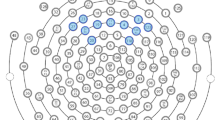Abstract
The present study investigated the development of the neural basis of pointing perception in 6-month- and 13-month-old infants. In a spatial-cueing paradigm, infants were presented with a peripheral target followed by a hand pointing toward (congruent condition) or away (incongruent condition) from the previously cued location. EEG responses to the presentation of the hand were measured. Thirteen-month-olds demonstrated larger amplitudes of ERP component P400 to incongruent compared to congruent pointing gestures over posterior temporal areas; 6-month-olds did not show any differential activation. This result suggests that the neural correlates of pointing perception undergo substantial development between 6 and 13 months of age.


Similar content being viewed by others
Notes
This p value referred to mean amplitude for congruent trial in the right hemisphere and was driven by one unusual high value in the non-pointer group (39.23 μV).
References
Allison T, Puce A, McCarthy G (2000) Social perception from visual cues: role of the STS region. Trends Cogn Sci 4(7):267–278
Benavides-Varela S, Hochmann J-R, Macagno F, Nespor M, Mehler J (2012) Newborn’s brain activity signals the origin of word memories. Proc Natl Acad Sci USA 109(44):17908–17913. doi:10.1073/pnas.1205413109
Carpenter M, Nagell K, Tomasello M (1998) Social cognition, joint attention and communicative competence from 9 to 15 months of age. Monogr Soc Res Child Dev 63:1–143
Cohen J (1988) Statistical Power Analysis for the Behavioral Sciences, 2nd edn. Erlbaum, Hillsdale
Daum MM, Ulber J, Gredebäck G (2013) The development of pointing perception in infancy: effects of communicative verbal cues on covert shifts of attention. Dev Psychol 49(10):1898–1908. doi:10.1037/a0031111
De Haan M (2007) Visual attention and recognition memory in infancy. In: De Haan M (ed) Infant EEG and event-related potentials. Psychology Press, New York
Deák GO, Flom RA, Pick AD (2000) Effects of gesture and target on 12- and 18-month-olds’ joint visual attention to objects in front of or behind them. Dev Psychol 36(4):511–523
Frodl T, Meisenzahl EM, Müller D, Leinsinger G, Juckel G, Hahn K, Hegerl U (2001) The effect of the skull on event-related P300. Clin Neurophysiol 112(9):1773–1776
Gredebäck G, Melinder AMD, Daum MM (2010) The neural basis and development of pointing comprehension. Soc Neurosci 5(5–6):441–450. doi:10.1080/17470910903523327
Hirai M, Senju A, Fukushima H, Hiraki K (2005) Active processing of biological motion perception: an ERP study. Cogn Brain Res 23:387–396
Iacoboni M, Dapretto M (2006) The mirror neuron system and the consequences of its dysfunction. Nat Rev Neurosci 7:942–951
Kristen S, Sodian B, Thoermer C, Perst H (2011) Infants’ joint attention skills predict toddlers’ emerging mental state language. Dev Psychol 47(5):1207–1219. doi:10.1037/a0024808
Legerstee M, Barillas Y (2003) Sharing attention and pointing to objects at 12 months: is the intentional stance implied? Cogn Dev 18:91–110
Lempers JD (1979) Young children’s production and comprehension of nonverbal deictic behaviors. J Genet Psychol 135:93–102
Leung EH, Rheingold HL (1981) Development of pointing as a social gesture. Dev Psychol 17(2):215–220
Liszkowski U, Carpenter M, Henning A, Striano T, Tomasello M (2004) Twelve-month-olds point to share attention and interest. Dev Sci 7(3):297–307
Liszkowski U, Carpenter M, Tomasello M (2007) Pointing out new news, old news, and absent referents at 12 months of age. Dev Sci 10(2):F1–F7
Luck SJ (2005) An introduction to the event-related potential technique. The MIT Press, Cambridge
Masataka N (1995) The relation between index-finger extension and the acoustic quality of cooing in three-month-old infants. J Child Lang 22(02):247–257. doi:10.1017/S0305000900009776
Meltzoff AN, Brooks R (2008) Self-experience as a mechanism for learning about others: a training study in social cognition. Dev Psychol 44(5):1257–1265. doi:10.1037/A0012888
Morissette P, Ricard M, D’ecarie TG (1995) Joint visual attention and pointing in infancy: a longitudinal study of comprehension. Br J Dev Psychol 13:163–175
Pelphrey KA, Singerman JD, Allison T, McCarthy G (2003) Brain activation evoked by perception of gaze shifts: the influence of context. Neuropsychologia 41(2):156–170
Pelphrey KA, Morris JP, McCarthy G (2004) Grasping the intentions of others: the perceived intentionality of an action influences activity in the superior temporal sulcus during social perception. J Cogn Neurosci 16(10):1706–1716. doi:10.1162/0898929042947900
Peña M, Maki A, Kovacić D, Dehaene-Lambertz G, Koizumi H, Bouquet F, Mehler J (2003) Sounds and silence: an optical topography study of language recognition at birth. Proc Natl Acad Sci USA 100(20):11702–11705. doi:10.1073/pnas.1934290100
Pfefferbaum A, Rosenbloom M (1987) Skull thickness influences P3 amplitude. Psychopharmacol Bull 23(3):493–496
Puce A, Allison T, Bentin S, Gore JC, McCarthy G (1998) Temporal cortex activation in humans viewing eye and mouth movements. J Neurosci 18(6):2188–2199
Rohlfing KJ, Longo MR, Bertenthal BI (2012) Dynamic pointing triggers shifts of visual attention in young infants. Dev Sci 15(3):426–435. doi:10.1111/j.1467-7687.2012.01139.x
Sato W, Kochiyama T, Uono S, Yoshikawa S (2008) Time course of superior temporal sulcus activity in response to eye gaze: a combined fMRI and MEG study. Soc Cogn Affect Neurosci 3:224–232
Senju A, Johnson MH, Csibra G (2006) The development and neural basis of referential gaze perception. Soc Neurosci 1(3):220–234. doi:10.1080/1747091060098979
Tomasello M, Carpenter M, Liszkowski U (2007) A new look at infant pointing. Child Dev 78(3):705–722
Von Hofsten C, Dahlström E, Fredriksson Y (2005) 12-month-old infants’ perception of attention direction in static video images. Infancy 8(3):217–231
Woodward AL, Guajardo JJ (2002) Infants’ understanding of the point gesture as an object-directed action. Cogn Dev 17(1):1061–1084
Acknowledgments
The study was supported by grants from the Norwegian Directorate for Children, Youth and Family Affairs (13/60525) to the first, second and third author.
Author information
Authors and Affiliations
Corresponding author
Rights and permissions
About this article
Cite this article
Melinder, A.M.D., Konijnenberg, C., Hermansen, T. et al. The developmental trajectory of pointing perception in the first year of life. Exp Brain Res 233, 641–647 (2015). https://doi.org/10.1007/s00221-014-4143-2
Received:
Accepted:
Published:
Issue Date:
DOI: https://doi.org/10.1007/s00221-014-4143-2




